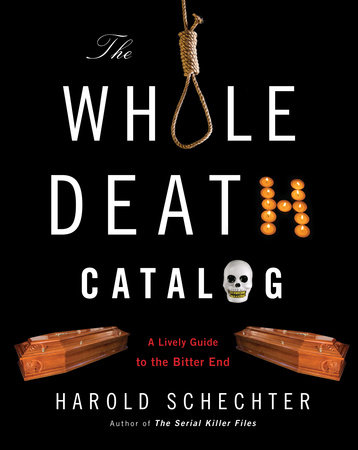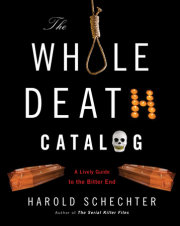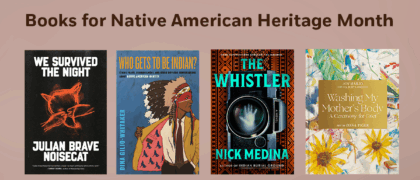Chapter One
DEATH Can’t Live with It, Can’t Live Without It
Is Death Necessary?
Of all the traits that distinguish human beings from other animals—language, toolmaking, the urge to buy other people’s unwanted stuff on eBay—perhaps the most fundamental is our awareness of our own inevitable deaths. To be sure, animals possess powerful survival instincts and do their best to avoid getting killed. But (so far as we know) they have no conscious knowledge of how little time they have here on earth. They go through life blissfully unaware that each passing day is bringing them closer and closer to the end.
Humans, on the other hand—particularly as we grow older—are all too keenly aware of how fleeting life is. On the plus side, this can add flavor and poignancy to our existence, making us savor the lovely and precious things in life (as the poet Wallace Stevens says, “Death is the mother of beauty”). But it also burdens us with a heavy load of anxiety and plagues us with the question “Why do we have to die at all?”
From time immemorial, humans have grappled with this mystery. Tribal myths from around the world offer a host of colorful explanations. According to one African tale, when the first humans pleaded with God to stop death, he complied with their wishes, but only on one condition: to prevent the world from becoming too crowded, there would be no more births. Unwilling to endure life without children, the people quickly begged God to return death to them.
In an Indonesian myth, death came into the world when God offered the first man and woman a choice between two gifts: a stone and a banana. Seeing no use for the stone, the pair chose the enticing fruit. At that instant, a voice thundered down from heaven: “Because you have chosen the banana, your life shall be like its life. When the banana tree has offspring, the parent stem dies. So shall you die and your children shall step into your place. Had you chosen the stone, your life would have been like its life, changeless and immortal.”
And then there is the Australian Aboriginal myth recorded by the anthropologists Ronald and Catherine Berndt. According to this story, two traveling companions named Moon and Djarbo suddenly fall mortally ill. Moon has a plan to revive them, but Djarbo—believing that Moon’s idea is a trick—rebuffs his friend’s help and soon dies. Moon dies also, but thanks to his plan he manages to revive himself into a new body every month, whereas Djarbo remains dead. “Thus, Moon triumphed over bodily death while the first peoples of that ancient time followed Djarbo’s example, and that is why all humans die.”
At first, people never died. As they grew older, they cast off their skins like snakes and crabs and came out with their youth renewed. One day, an elderly woman went to a stream to change her skin. She shed the old skin and threw it in the water, then watched as it floated downstream and caught on a stick. Then she went home, where she had left her little son. As soon as the child saw her, however, he began to cry because he did not recognize her. “You are not my mother. My mother was an old woman.” To pacify the child, the woman returned to the stream, found the cast-off skin, and put it back on. From that day on, humans ceased to shed their skin and died. —Melanesian myth
Of course, these fanciful stories can’t be taken seriously. Clearly, they are the products of primitive, childlike minds—nothing more than fairy tales. After all, the real truth, as every biblical fundamentalist will tell you, is that death came into the world when Satan in the form of a talking snake gave a forbidden apple to a naked woman created from the rib of her slumbering mate. Of course, some scientists reject even this persuasive explanation. As far back as the eighteenth century, the famed botanist Carl Linnaeus, father of modern taxonomy, accounted for death in ecological terms. As Linnaeus saw it, death served to maintain a fundamental balance in nature by ensuring that no single species of plant or animal would overrun the earth through unchecked reproduction. In the following century, Claude Bernard—the founder of modern physiology—viewed obsolescence and death as intrinsic characteristics of living beings, the flip side of embryonic development and birth. “Existence,” he wrote, “is nothing other than a perpetual alternation of life and death, composition and decomposition. There is no life without death; there is no death without life.”
The Bernardian belief that death is a biological necessity has been endorsed by subsequent thinkers, among them the German physician Wilhelm Fliess (one of Freud’s early collaborators), who compared the human body to a “wound up clock that carries within itself the law of its own unwinding.” In a similar vein, the Hungarian psychologist Leopold Szondi coined the term thanatropism to describe “an unknown force in every living being driving it toward death.”
At least one famous nineteenth-century scientist, however, took issue with the view of death as an inescapable aspect of life. The great German biologist August Weismann argued that, contrary to what most people assume, “death is not an inevitable phenomenon.” Some living beings, he insisted, can exist forever. As proof, he pointed to the case of unicellular organisms, which reproduce themselves by splitting in two and therefore enjoy a kind of immortality.
Clearly, this is an excellent state of affairs if you happen to be an amoeba. Even Weismann, however, acknowledged that higher organisms (including, sadly, human beings) cannot avoid death.
The concepts put forth by Weismann—who is widely regarded as the most important evolutionary theorist of the nineteenth century after Darwin himself—have contributed significantly to the current scientific understanding of death. Weismann distinguished between what he called the “germ cells”—essentially the sperm and ova that carry our genes—and the “somatic cells” that constitute our bodies. In this view, the body is nothing more than a vehicle for transmitting our genes to future generations. Once this task is accomplished—once reproduction has taken place—the body becomes disposable. There’s no biological point in keeping it alive forever. In fact, there are positive advantages to getting rid of it, since the elimination of older individuals frees up important resources for the young and thus ensures the perpetuation of the species, which is all that nature cares about.
Of course, this doesn’t entirely explain why humans have the potential to live to a ripe old age and don’t simply expire as soon as they fulfill their reproductive mission, in the way of other creatures from praying mantises to salmon. Here, too, evolutionary biology suggests an answer. Thinkers who subscribe to this theory argue that since human offspring require years of parental care, we are genetically programmed to remain alive long past our reproductive prime so that we can protect our children and ensure their survival (scientists call this the “grandmother effect”). Thanks to our kids, we are endowed with “post-reproductive longevity.” So the next time you contemplate those college tuition payments, just remember: you may think those bills are killing you, but they’re actually helping to keep you alive.
RECOMMENDED READING
André Klarsfeld and Frédéric Revah’s The Biology of Death: Origins of Mortality (Cornell University Press, 2004) is an excellent survey of scientific theories of death. Another is the first chapter of Jacques Choron’s Modern Man and Mortality (Macmillan, 1964). George Wald, the eminent Harvard biologist who won the Nobel Prize in 1967, delivered an elegant and wonderfully lucid lecture on the origin of death, which can be found online at www.elijahwald.com/origin.html.
In one sense, people in all times and places have felt pretty much the same about dying. Generally speaking, we’d prefer not to. Apart from this natural desire to avoid death, however, there’s no such thing as a single worldwide way of viewing mortality. Cultural attitudes have differed throughout time and across the globe.
Judging from the epic of Gilgamesh—the world’s oldest written narrative, which dates back to at least 1300 b.c.—the ancient Babylonians conceived of the afterworld as the “house of darkness,” a grim subterranean realm where the dead exist in a state of unrelieved wretchedness. This view led them to adopt an eat-drink-and-be-merry philosophy, articulated in the story by a “wine maiden” named Siduri, who counsels the hero “to make every day a day of rejoicing. Day and night do thou dance and play.” In short, it was important for everyone, whether commoner or king, to make the most of his time on earth, since death was an unavoidable catastrophe—the natural, universal (if dreadful) fate of humankind.
Among many aboriginal tribes, on the other hand, there is nothing at all natural about death. In this view, every death—even that of an elderly person—is essentially an act of murder brought about by witchcraft. Slain by a malevolent, unseen enemy, the victim is likely to return as a vengeful spirit. For the Kaingáng of Brazil, for example, the passing of any individual threatens the welfare of the entire tribe. Transformed into an evil “ghost-soul,” the deceased (in the words of funerary scholars Robert Habenstein and William Lamers) “craves a companion from among the living.” Surviving spouses are particularly vulnerable and will immediately decamp from the village, armed with a particular variety of large jungle fern—a horticultural charm apparently much feared by ghost-souls. Only after the corpse is safely cremated and buried (in a hole lined with additional ferns to keep the malevolent spirit trapped inside) will the frightened survivor venture to return.
By contrast, Hindus view death not as an evil but as a natural stage in the evolution of the soul, which undergoes successive reincarnations until it attains salvation and is freed from the cycle of dying and rebirth. In the words of one sage: “Our soul never dies; only the physical body dies. We neither fear death nor look forward to it, but revere it as a most exalted experience. Life, death and the afterlife are part of our path to perfect oneness with God.”
In Western society, views of death have changed dramatically over the millennia, as French social historian Philippe Ariès was the first to document. Ariès famously identified four distinct stages in European attitudes toward death, from the calm acceptance of the early medieval period to the denial and avoidance characteristic of the modern age.
American death attitudes have undergone major transformations since the days of the early colonists. For the New England Puritans, death was an omnipresent reality. Their median life expectancy was thirty-three, and the mortality rate among children was so high that, according to historian David Stannard, when a young couple in seventeenth-century Massachusetts got married, they “did so with the knowledge and expectation that in all probability two or three of the children they might have would die before the age of ten.”
Their familiarity with death, however, did not make the contemplation of their own inevitable end any less anxiety-provoking. As Calvinists, they saw all humans (even newborns) as hopelessly depraved sinners, the vast majority of whom were predestined to spend eternity suffering the torments of hell. They might hope and pray for salvation. But to a very large degree, death remained the “king of terrors.”
Nor did they attach any sentimental value to the physical remains of their loved ones. As funeral historian Gary Laderman observes, to the Puritans “the corpse was a horrible sight” that symbolized human sin and corruption. Once the soul had departed, the body was just a vile lump of flesh, undeserving of any special treatment. Thus, the Puritans “did not approve of embalming, elaborate funerals, or extravagant tombs.” The newly dead corpse was “hurried into the ground with little ceremony”—“commended to the cold and silent Grave where it must be entertained with Worms and Rottenness, and turned into putrefaction” (as one Puritan divine so vividly put it).
By the mid-nineteenth century, a far more romanticized attitude toward death had taken hold in the United States. Early Puritan graveyards were bleak, untended places, their stark tombstones carved with winged skulls, scythes, and other grim reminders of life’s brevity. Beginning in the mid-1800s, picturesque “garden cemeteries” sprang up across the country: lush, rural burial grounds, as beautifully landscaped as any park and dotted with mawkish memorial statuary—empty cradles and inconsolable pets and little children in peaceful repose.
Death became an occasion for sentimental excess. Ladies’ magazines devoted countless features to the latest in mourning fashions; women adorned themselves with “hair jewelry” made from the locks of their deceased loved ones; front parlors were hung with postmortem portraits and memorial lithographs of grieving survivors posed beside tombs and surrounded by weeping willow trees. Shamelessly sappy verse about the tragic deaths of toddlers became a wildly popular poetic genre. Heaven itself came to be seen differently: not as the place where one’s soul received its final (and, for the vast majority of humans, dreadful) judgment but (to quote Stannard) as “a domesticated haven, a place where all would be welcomed home”—a kind of celestial version of a comfortable, middle-class Victorian household.
As the Victorian age gave way to the modern era, powerful social factors—urbanization, advances in medical science, the breakdown of tight-knit communities, a growing secular outlook that undermined the traditional faith in an afterlife—caused another major shift in American death attitudes. The dead were segregated from the living, banished from sight. People no longer expired at home surrounded by their loved ones but died in sterile hospital rooms, tended by strangers. The elaborate mourning rituals of earlier times were abandoned, rendered obsolete by the feel-good ethos of contemporary U.S. consumer culture (what sociologists Nathan Leites and Martha Wolfenstein call American “fun morality”). Funerals became, in the caustic phrase of sociologist Robert Fulton, “low-grief” affairs. With the spread of “perpetual care” cemeteries, visiting the final resting places of departed family members to pay respects and tend their graves became an increasingly quaint and outmoded custom.
Death itself became a taboo topic, something not to be dwelled upon or even spoken of. In her excellent book, Death’s Door: Modern Dying and the Ways We Grieve (Norton, 2006), Sandra Gilbert relates an anecdote that perfectly captures the extent to which death has become an unmentionable subject in our time. In the mid-1990s, while compiling a book called Confronting Death, sociologist David Moller asked the American Cancer Society for permission to include some of its materials. “Its representative,” writes Gilbert, “responded with a statement that’s distinctively ‘modern’: ‘Absolutely not. In no way do we want to be associated with a book on death. We want to emphasize the positive aspects of cancer only.’”
RECOMMENDED READING
Philippe Ariès’s seminal studies of Western death attitudes are, of course, essential reading for anyone interested in this topic. David Stannard’s The Puritan Way of Death (Oxford, 1977) is an elegant and illuminating book on the topic of early American conceptions of mortality. William Wood and John B. Williams’s contribution to The Handbook of Death and Dying (Sage Publications, 2003)—a highly informative essay, “Historical Changes in the Meaning of Death in the Western Tradition”—is also well worth reading.
Philippe Ariès (1914–1984) was, in the strict sense of the term, a true amateur, a word that now connotes a lack of professional skill but originally meant a person who does something for love, not money (it is linguistically related to amorous). Certainly he did not earn his keep as a historian. He was a French civil servant who spent his career working for the Institute for Applied Research for Tropical and Subtropical Fruits. But as a part-time scholar (what he himself referred to as a “weekend historian”), he made significant contributions to the study of Western society. As a historian, Ariès was less interested in momentous events—wars, revolutions, world-changing discoveries—than in the fundamental phenomena of everyday existence. After writing an influential book on the first phase of life, Centuries of Childhood (Vintage, 1962), he turned his attention to the final one. The result was his groundbreaking study, Western Attitudes Toward Death from the Middle Ages to the Present (Johns Hopkins University Press, 1974).
In this slender volume (which grew out of a series of lectures), Ariès argues that over the course of the second millennium, the European response to death passed through four stages. The earliest—which he labels “tame death”—was distinguished by a resigned acceptance of mortality. “In death,” Ariès writes, “man encountered one of the great laws of the species, and he had no thought of escaping it or glorifying it. He merely accepted it with just the proper amount of solemnity due one of the important thresholds which each generation always had to cross.”
As the centuries progressed, this attitude underwent a gradual change. By the late Middle Ages, the traditional acceptance of death as the “common destiny of the species” was replaced by a new emphasis on the fate of the individual. This second stage—which was characterized by both a heightened anxiety about the state of one’s soul and a growing attachment to the things of this world—Ariès calls “one’s own death.”
A new attitude appeared at the start of the eighteenth century—an intense, morbid fascination with death that culminated in the excesses of Victorian mourning rituals: extravagant funerals, elaborate widow’s garb, lush garden cemeteries, et cetera. The emphasis during this period—which lasted until the early decades of the twentieth century—was on the loss of the loved one: what Ariès defines as a shift from “my death” to “thy death.”
Ariès describes our own period as the age of “forbidden death,” when the terminally ill are bundled off to hospitals to die alone and out of sight. Death—“so omnipresent in the past that it was familiar”—has become shameful and hidden. If that situation has begun to change—if we are no longer quite so reluctant to confront and talk about death—that salutary shift is at least partly due to the influence of Ariès himself, who elaborated his insights in his last major work, The Hour of Our Death (Knopf, 1981)
Copyright © 2009 by Harold Schechter. All rights reserved. No part of this excerpt may be reproduced or reprinted without permission in writing from the publisher.






